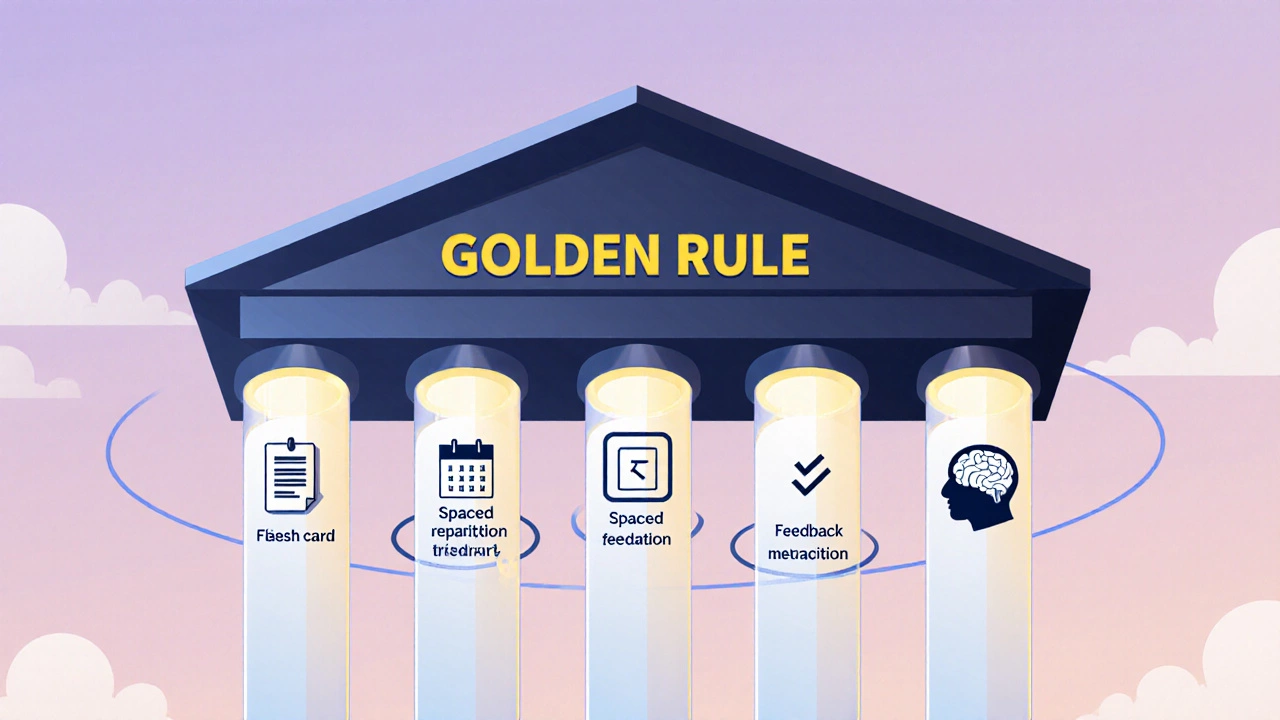Spaced Repetition Scheduler
Calculate Your Learning Schedule
Enter your first study date to get your optimal review schedule based on the 1-3-7-14 spaced repetition method
Quick Takeaways
- The golden rule of learning is: learn by teaching.
- Combine active recall, spaced repetition, and feedback for maximum retention.
- Use metacognition to spot gaps before they become habits.
- Apply deliberate practice and chunking to speed up mastery.
- Stay motivated by linking new knowledge to personal goals.
What the Golden Rule of Learning Actually Means
When people talk about the Golden Rule of Learning is a simple yet powerful principle that says you retain information best when you actively teach it to another person or a future version of yourself. The idea isn’t new - Socrates used dialogue, apprentices learned by showing their masters, and modern educators still ask students to explain concepts back.
Why does it work? Teaching forces you to retrieve, reorganize, and articulate knowledge, turning passive exposure into an active mental workout. That extra work builds stronger neural pathways, so you remember longer and can apply the material in new situations.
Core Pillars That Support the Golden Rule
Think of the golden rule as a roof. Underneath are four sturdy beams that keep it stable. Each beam is a well‑studied learning technique that makes teaching easier and more effective.
- Active Recall is a process where you pull information from memory instead of just rereading it. Flashcards, self‑quizzes, and teaching are classic examples.
- Spaced Repetition is a schedule that spaces review sessions farther apart as you become more familiar with the material. The 1‑3‑7‑14 day rule works for most subjects.
- Feedback is a quick, specific response that tells you whether your explanation was accurate. Peer review, quizzes, or AI tools can be sources.
- Metacognition is a self‑awareness about your own thinking and learning processes. It helps you spot gaps before you start teaching.

How to Put the Golden Rule Into Practice
- Choose a topic you want to master.
- Study it using active recall - close the book, write what you remember.
- Schedule spaced‑repeat sessions: review after 1 day, then 3, then 7, etc.
- Explain the concept out loud to a friend, a study group, or even a rubber duck.
- Ask for feedback. Did your listener understand? Did they ask follow‑up questions?
- Reflect on the experience. Note which parts felt shaky (that’s metacognition at work).
- Repeat the cycle, gradually increasing the depth and complexity of your teaching.
Because each loop forces you to retrieve, reorganize, and verbalize, the material moves from short‑term to long‑term memory much faster than passive reading.
Common Pitfalls and How to Avoid Them
Even with the best intentions, learners stumble. Here are the usual suspects and quick fixes.
- “I’m just talking, not testing.” - Pair teaching with a quick quiz for yourself. If you can answer five random questions correctly, you’re ready to teach.
- “I repeat the same words I heard.” - Force yourself to rephrase in your own language. Use analogies from your daily life.
- “I wait too long before reviewing.” - Set phone reminders or use an app that automates spaced repetition.
- “I don’t get feedback.” - Join a study community, use language‑learning apps with correction features, or record yourself and listen back.
Real‑World Examples That Show the Power of Teaching
Deliberate Practice is a focused, goal‑oriented activity that targets specific weaknesses. Chess masters often explain openings to novices; the act of breaking down each move highlights subtle patterns they might miss otherwise.
Medical students spend their clerkships teaching patients simple health checks. By translating jargon into plain language, they cement the underlying anatomy and physiology.
In the tech world, developers write blog posts about a new framework. The act of documenting code, edge cases, and performance tips forces them to understand the internals far beyond a “copy‑paste” level.

Quick Checklist - Is Your Learning Session Following the Golden Rule?
| Step | What to Verify |
|---|---|
| Active Recall | Did you retrieve information without notes? |
| Spaced Repetition | Is a review scheduled within the optimal interval? |
| Teaching | Did you explain the concept to another person or a recorded audience? |
| Feedback | Did you receive at least one specific correction or affirmation? |
| Metacognition | Did you note any gaps or new questions? |
Beyond the Golden Rule - Complementary Techniques
While teaching is the anchor, a few extra tools can boost your results.
- Chunking is a method of breaking large amounts of information into smaller, meaningful units. Pair chunks with a teaching segment for each.
- Intrinsic Motivation is a personal drive that comes from genuine interest rather than external rewards. Connect new material to a hobby or career goal.
- Interleaving is a practice of mixing different subjects or problem types in one study session. It forces the brain to stay flexible, which improves teaching clarity.
Getting Started Today
Pick a 30‑minute slot this week. Choose a topic you already know a little about - maybe a recent article you read. Follow the seven‑step cycle above, record yourself, and share the recording with a friend. The moment you hear yourself stumble, you’ll see the gaps that need work. That’s the golden rule in action.
Frequently Asked Questions
Why does teaching improve my own understanding?
Teaching forces you to retrieve information, reorganize it, and present it clearly. Those mental steps create stronger connections in the brain, turning short‑term knowledge into long‑term mastery.
Can I use the golden rule for skills that aren’t language‑based, like sports?
Absolutely. Explaining a technique to a teammate, a coach, or even a video blog makes you articulate the movement steps, timing, and common mistakes - all of which reinforce your own skill.
How often should I repeat the teaching cycle?
Start with a daily mini‑session for the first week, then shift to every other day as confidence grows. Use spaced repetition intervals (1‑3‑7‑14 days) to keep the knowledge fresh.
What if I don’t have a willing audience?
Record yourself on your phone or computer. Playback lets you hear gaps, and you can also upload the video to a private forum for feedback.
Is the golden rule suitable for beginners?
Yes. Beginners benefit most because teaching makes them confront the exact points they don’t yet understand, speeding up the learning curve.






